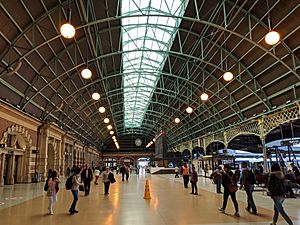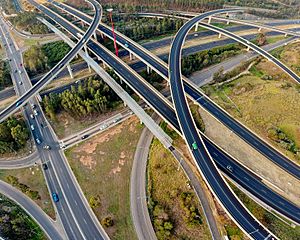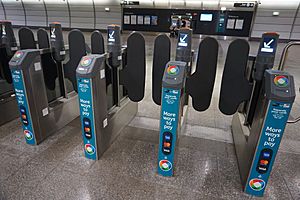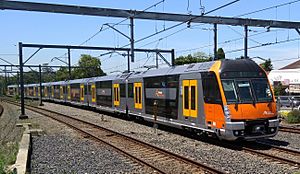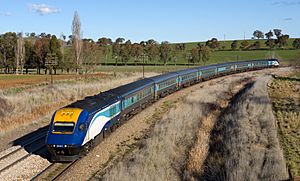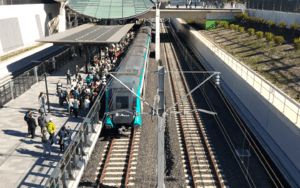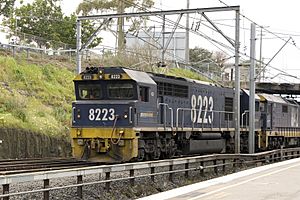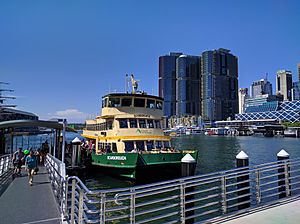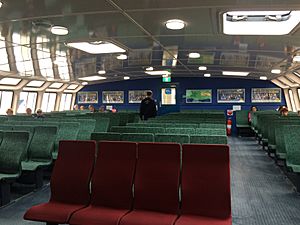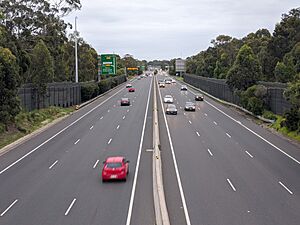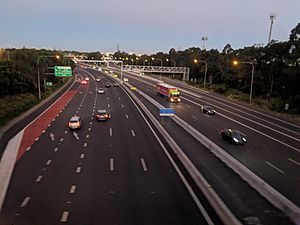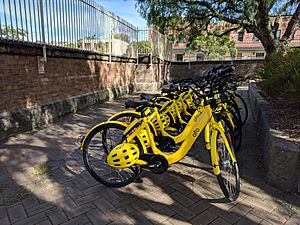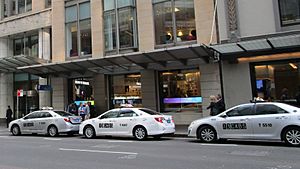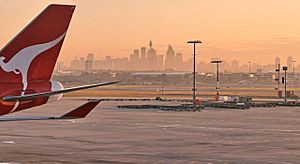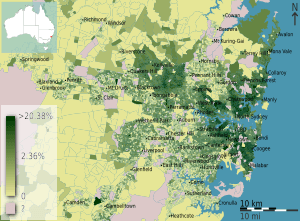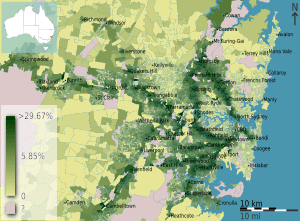Transport in Sydney facts for kids
Sydney is a big city in Australia, and it has many ways for people to get around! You can travel by metro, train, bus, ferry, and light rail. There are also lots of roads for cars, special paths for bikes, and airports for planes.
Did you know that Sydney has one of the highest rates of public transport use in Australia? More than 80% of trips to and from the city center on weekdays are made using public transport! The whole system is managed by a group called Transport for NSW.
Contents
How Sydney's Transport Grew
Sydney's transport system has a long history. The city started growing outwards partly because of its train network and the popularity of cars. The very first train services began in 1855. A tram network also started in 1861 and became the biggest in the Southern Hemisphere by the 1920s! This train system allowed people to live further away from the city center.
How to Pay for Your Trip
When you use public transport in Sydney, you'll use something called an Opal card. This is a special card you tap when you get on and off your journey. It's a contactless system, meaning you just tap the card without needing to swipe it. The Opal card system was fully set up by 2014. Before that, people used different kinds of tickets. The prices for trips are decided by the New South Wales Government.
Buses in Sydney
Buses are a very popular way to travel in Sydney, making up about half of all public transport trips on weekdays. Private companies run these bus services under contracts with Transport for NSW. Some of the biggest bus companies include CDC NSW, Busways, and Transit Systems.
Bus Routes and Special Lanes
Sydney's bus network is split into different areas, and bus routes have three-digit numbers. Sydney also has special bus lanes called T-Ways. These are like dedicated roads just for buses, which helps them travel faster and avoid traffic.
- The Liverpool-Parramatta T-way opened in 2003.
- The North-West T-way opened in 2007.
Trains and Metro
Getting Around Sydney by Train
Sydney Trains runs the suburban train services within Sydney. Most of these train lines go underground through the city center. All city trains have eight double-deck carriages, meaning they have two levels for passengers! There are two crew members on board: a driver and a guard. Your train fare depends on how far you travel. Trains usually run from 4 AM until about 1 AM every day. If you need to travel late at night, there are special Nightride bus services that cover the train network when trains aren't running.
NSW TrainLink also runs trains from Central Station to places outside Sydney, like the Blue Mountains or Newcastle. Central Station is also where long-distance trains leave for other parts of New South Wales, and even to Melbourne and Brisbane. There's even a famous train called the Indian Pacific that travels all the way to Adelaide and Perth!
Sydney's Metro System
The Sydney Metro is a modern, fully automated train system. This means the trains drive themselves! It first opened in 2019 and connects Sydney's north-western suburbs to Chatswood, which is a major transport hub.
Work is currently happening to make the metro line even longer. It will eventually go through the city center, under Sydney Harbour, and then south-west to Bankstown. When it's finished, this line will have 31 stations and cover about 66 kilometers (41 miles) of tracks. Sydney is the first and only city in Australia with a fully automated metro system.
Trains for Goods
Freight trains, which carry goods, also use many of Sydney's railway lines. However, because there are so many passenger trains, freight trains usually can't run during busy morning and afternoon times.
The main types of goods carried by train are containers. These are big metal boxes filled with products. There are also coal trains that go to Port Kembla. Several companies operate these freight trains, including Aurizon and Pacific National.
Trams and Light Rail
Sydney used to have the biggest tram network in the Southern Hemisphere! It ran from 1861 until it closed in 1961. At its busiest in 1945, 405 million passenger trips were made on the trams.
However, light rail is making a comeback!
- In 1997, the Inner West Light Rail line opened. It's now 12.8 kilometers (8 miles) long.
- The CBD and South East Light Rail opened in stages between 2019 and 2020. It runs through Sydney's city center from Circular Quay to Randwick and Kingsford.
- The Parramatta Light Rail is currently being built and is expected to open in 2024. It will connect Westmead station to Carlingford via Parramatta. There are also plans for a second line in the Parramatta area.
How Punctual Are Sydney's Trains?
Sydney's train network has been known for being on time. However, a report in 2017 mentioned that longer-distance intercity trains sometimes run less on time compared to the suburban trains.
Ferries on Sydney Harbour
Sydney Ferries Services
Sydney Ferries operates many ferries on Sydney Harbour and the Parramatta River. These ferries are used by both people going to work and tourists enjoying the sights. Ferries on Sydney Harbour are popular for both, while those on the Parramatta River are mostly used for fun trips and tourism.
Sydney Ferries has nine routes and carries about 14 million passengers each year! Their main hub is Circular Quay, a big transport spot in the city center. Popular routes include trips to Manly and Taronga Zoo, which is a major tourist attraction. Sydney Ferries also offers special sightseeing cruises for visitors.
Other Ferry Companies
Besides Sydney Ferries, several private companies also run passenger ferries in the Sydney area. These include:
- Church Point Ferry, which goes to Scotland Island.
- Cronulla & National Park Ferry Cruises, from Cronulla to Bundeena.
- Dangar Island Ferries, from Brooklyn to Dangar Island.
- Captain Cook Cruises, offering trips around Darling Harbour and to places like Taronga Zoo.
- Palm Beach Ferry, connecting Palm Beach to Great Mackerel Beach and Ettalong Beach.
Car Ferries
Sydney also has several car ferries that are part of the road system. These ferries help cars cross rivers and are free to use. They are managed by Transport for NSW and local governments. Some examples include:
- Berowra Waters Ferry, across Berowra Creek.
- Mortlake Ferry, across the Parramatta River.
- Wisemans Ferry, across the Hawkesbury River.
Roads and Motorways
Roads and motorways are very important for getting around Sydney, as many households rely on one or two cars. Sydney has about 160 kilometers (100 miles) of motorways, freeways, and toll roads. Even with so many cars, Sydney still has the highest rate of public transport use in Australia!
Highways in Australia are usually known by names, not just numbers. These names often come from famous explorers, important politicians, or geographic areas.
Some of the major motorways and highways in Sydney include:
- Eastern Distributor
- M1 Pacific Motorway
- M2 Hills Motorway
- M4 Motorway
- M5 Motorway
- Westlink M7
- Sydney Harbour Tunnel (or Sydney Harbour Bridge)
Cycling Around Sydney
Cycling in Sydney is popular for fun, getting to work, and as a sport. Sydney has some hills, so cyclists might need to be a bit fitter than in flatter cities like Melbourne. Because Sydney has a lot of traffic, cyclists sometimes share busy roads with cars. However, Sydney has a mild climate, which is great for cycling, and there are many active cycling groups.
Most cyclists ride on the road with cars. Special bike paths, called cycleways, have been built in parks and other areas. The City of Sydney has been working to build more separated cycleways, which are paths just for bikes, to make cycling safer and easier.
Taxis in Sydney
Sydney and its surrounding areas have about 6,000 taxis, and over 22,700 taxi drivers! This is the largest number of taxis and drivers in Australia.
Most taxis are owned by small businesses. These owners pay fees to join radio networks, which help them get bookings by phone or internet. The prices for taxi rides are set by a group called the Independent Pricing and Regulatory Tribunal. Other rules for taxis are managed by Transport for NSW.
Airports in Sydney
Sydney's main airport is Sydney Airport, which is the busiest airport in Australia. It handles up to 43 million international and domestic passengers every year! The airport is only eight kilometers (5 miles) from Sydney's city center. Because so many people use it, a new airport called Western Sydney Airport is being built in Badgerys Creek to help with the growing number of travelers.
The Greater Sydney area also has smaller airports like Bankstown Airport and Camden Airport. These are used for shorter flights and recreational flying.
Public Transport Facts
On average, people in Sydney spend about 82 minutes commuting on public transport on a weekday. About 31% of public transport users travel for more than 2 hours every day! The average wait time at a stop or station is 13 minutes, but 18% of riders wait for over 20 minutes daily. The average distance people travel in one public transport trip is 9 kilometers (5.6 miles), with 21% traveling more than 12 kilometers (7.5 miles) in a single direction.


